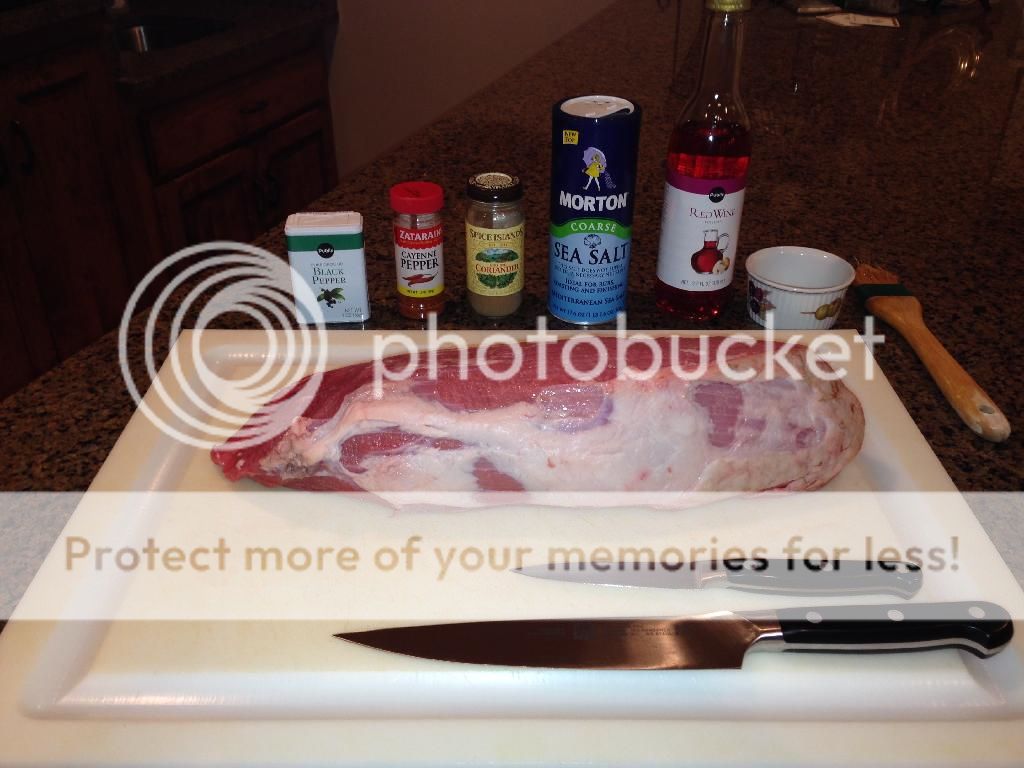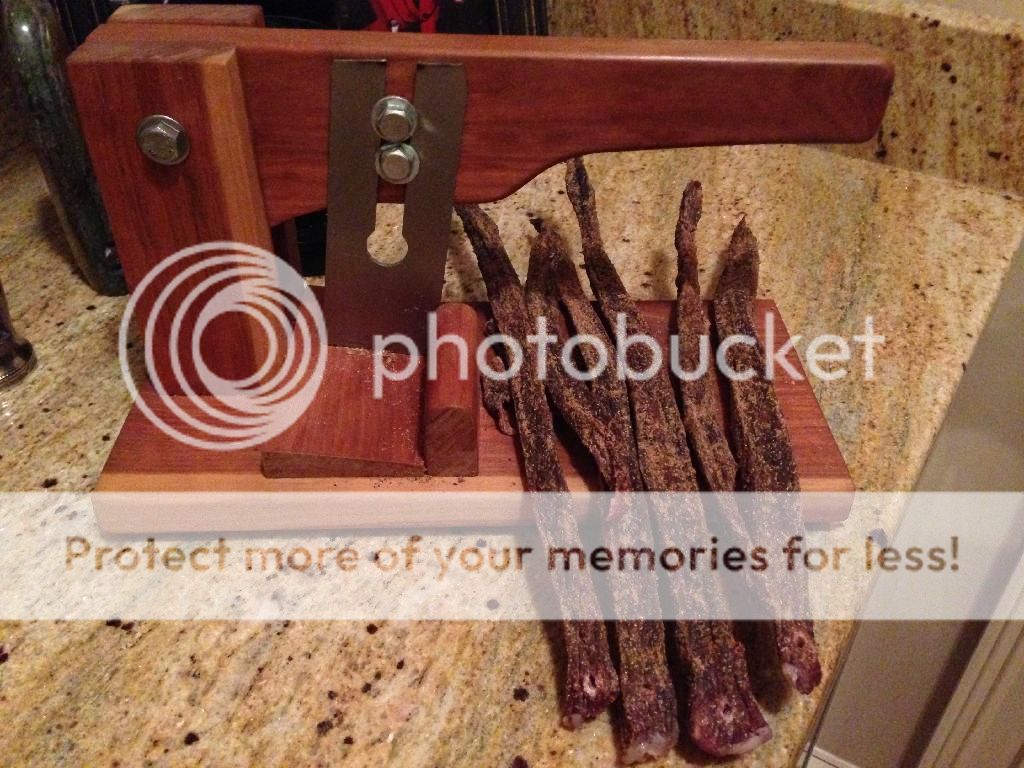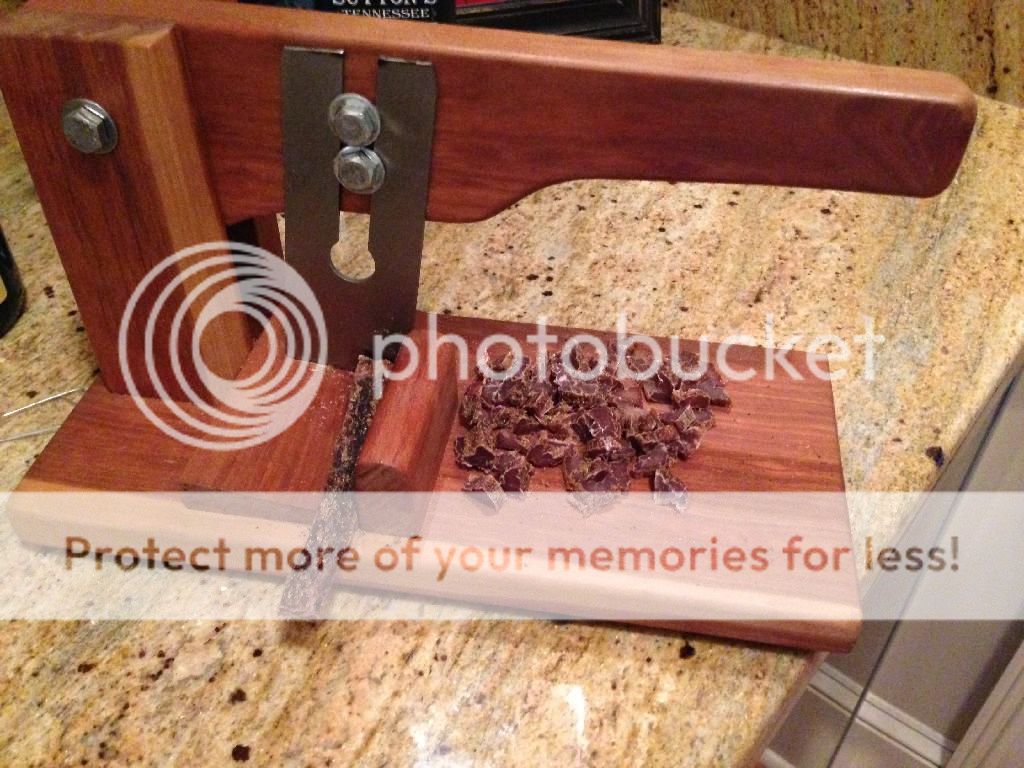Jorge400
Well-known member
I've seen some theads on here about jerky and thought I would share how I make biltong. Biltong is similar to jerky that is popular in southern Africa. The main difference in biltong and our jerky is the main spice (coriander) and the lack of any heat in the drying process.
With a little advice from some South African friends and a little internet research, I built my own biltong box and started making biltong.

I built my box out of a single sheet of 3/4" plywood. The interior has two compartments. The lower compartment houses a light bulb and has vent holes on the side and the board the separates the upper and lower compartment. The light bulb helps dry the air circulating up through the box and adds very, very little heat.

The upper compartment is where I hang the meat. At first I had vent holes in this section too and just allowed the air to convect upwards from the lower compartment to the upper; however, I added a computer exhaust fan in the top of the box and ended up covering up the holes in the top of the box.

I make my biltong in the colder months due to the lower humidity levels here in the South. The unfinished part of my basement is dry and cool so that is where I have my box. As you can see, the temps in the room are in the high 60s and humidity is about 55%.

Inside the box, the light bulb brings the temps up slightly and drops the humidity down below 50%.

In Africa they make biltong from a wide variety of meats. There I've had meat from beef to zebra and dried sausage made from who knows what. I've tried using whitetail with not much luck so I stick to beef. Lately I have been using a whole eye of the round but I have also used flank steak and london broil.

Biltong can be made with a number of different spices but the most common in my opinion are coriander and black pepper. The main ingredients I use are coriander, black pepper and cayenne. Coarse sea or kosher salt and vinegar are also needed in the process.
I start by timming most of the fat off the roast (some like to keep a fair bit of fat) and cutting the meat with the grain into strips about 1" x 1/2" and covering them lightly in salt. I then put it back in the refrigerator for an hour. This will help draw out some moisture and add a salty flavor.

After an hour, I scrape off most all the salt. This is very important or it will be far too salty. I then brush each side with a very light coat of vinegar and add cayenne, black pepper and coriander in that order and increasing amounts of each. I then hang the strips in the box with the thickest end at the top. Be sure they are not touching. Close the box and turn the fan and light.

Depending on the humidity level, it typically takes between 3 and 5 days to cure to the level I like. Unless you cut them all uniform, they won't all be cured to the same degree at the same time.

This is where personal preference comes in. Some like it a "wet", which means a bit raw on the inside. I take it out when the strips are pretty hard and not spongy when I squeeze the thickest part. These strips had been in for about 3.5 days.

I make several batches during the winter and having a biltong cutter comes in handy.

Give it a try and let me know if you have any questions.
George
With a little advice from some South African friends and a little internet research, I built my own biltong box and started making biltong.

I built my box out of a single sheet of 3/4" plywood. The interior has two compartments. The lower compartment houses a light bulb and has vent holes on the side and the board the separates the upper and lower compartment. The light bulb helps dry the air circulating up through the box and adds very, very little heat.

The upper compartment is where I hang the meat. At first I had vent holes in this section too and just allowed the air to convect upwards from the lower compartment to the upper; however, I added a computer exhaust fan in the top of the box and ended up covering up the holes in the top of the box.

I make my biltong in the colder months due to the lower humidity levels here in the South. The unfinished part of my basement is dry and cool so that is where I have my box. As you can see, the temps in the room are in the high 60s and humidity is about 55%.

Inside the box, the light bulb brings the temps up slightly and drops the humidity down below 50%.

In Africa they make biltong from a wide variety of meats. There I've had meat from beef to zebra and dried sausage made from who knows what. I've tried using whitetail with not much luck so I stick to beef. Lately I have been using a whole eye of the round but I have also used flank steak and london broil.

Biltong can be made with a number of different spices but the most common in my opinion are coriander and black pepper. The main ingredients I use are coriander, black pepper and cayenne. Coarse sea or kosher salt and vinegar are also needed in the process.
I start by timming most of the fat off the roast (some like to keep a fair bit of fat) and cutting the meat with the grain into strips about 1" x 1/2" and covering them lightly in salt. I then put it back in the refrigerator for an hour. This will help draw out some moisture and add a salty flavor.

After an hour, I scrape off most all the salt. This is very important or it will be far too salty. I then brush each side with a very light coat of vinegar and add cayenne, black pepper and coriander in that order and increasing amounts of each. I then hang the strips in the box with the thickest end at the top. Be sure they are not touching. Close the box and turn the fan and light.

Depending on the humidity level, it typically takes between 3 and 5 days to cure to the level I like. Unless you cut them all uniform, they won't all be cured to the same degree at the same time.

This is where personal preference comes in. Some like it a "wet", which means a bit raw on the inside. I take it out when the strips are pretty hard and not spongy when I squeeze the thickest part. These strips had been in for about 3.5 days.

I make several batches during the winter and having a biltong cutter comes in handy.

Give it a try and let me know if you have any questions.
George



